Megaton Man (1984) #1-10,
The Return of Megaton Man (1988) #1-3,
Megaton Man Meets The Uncategorizable X+Thems (1989) #1,
Yarn Man (1989) #1 by Don Simpson and others
With Megaton Man #1, we enter into Kitchen Sink’s third phase: Kitchen Sink was first an underground publisher, then as the undergrounds disappeared, Kitchen Sink’s output became dominated by strip reprint magazines and high class albums (The Spirit and Steve Canyon), and with Megaton Man they started dipping their toes into the indie comics market.
I’ve got the reprint edition of Megaton Man #1 — the original one was in colour, I think? I had a couple of issues of the series as a teenager, but I wasn’t really interested. Which is odd, because the humour (zany and silly) is just the kind of thing I like.
It should work? And perhaps it does? But for me, there’s something ineffably offputting about it.
It’s quite possible that it’s the artwork that’s annoying me. Obviously, Simpson is really, really into drawing over-rendered people and… well… not much else, so there’s all these highly rendered, badly drawn characters floating in voids. It’s really un-stylish.
I mean, look at that drawing of Megaton Man typing away — it’s almost kinda really good? That’s almost a Ty Templeton drawing. But if he’d done it, it would have been stylish and fun instead of… lumpy.
It might be my totally rational hatred of bobble-headed figures (I hate and loath Funko Pop with my entire being), and Simpson’s characters are really bobbled (especially in the earliest issues). With those creepy huge eyes on all the female characters. It’s just creepy.
It’s a very large cast of characters, and a large number of references to Doonesbury… which… as random things go, is really random.
I’ve got the rest of the run in colour, and that does indeed help quite a bit. I think Simpson’s trying out different things with the artwork, especially going back and forth as to how cartoony the faces should be. Sometimes he lands in this … horrible, horrid no mans land that’s just icky.
Is that just me? Huh? Huh?
Did I mention how the backgrounds fade in and out without much rhyme or reason? (It took me almost a week to read these comics, so I may be repeating myself…)
I guess the joke here is that Trudeau uses assistants?
Oh, wow. Suddenly: Four pages of Love & Rockets references.
I really get the feeling that Simpson didn’t know what he wanted to do with Megaton Man. It’s all over the place, but not in… an interesting way?
This seems so jarring… OK, on the next page she leaves him, but still.
It’s also a frustrating read because nothing seems to actually develop. It feels like the ten issues of the first series happen over a couple of days, but that’s because we go back and revisit a couple of scenes so many times. We’ve see this scene, like, five times? And it’s not like it’s just a recap, either, because there’s also a recap on the inside front cover. Instead it seems like Simpson just really likes drawing these scenes over and over, so that’s what we get.
Or perhaps he just didn’t know where to take the plot, and whenever he was stuck, he just put in an earlier scene (as a flashback, a dream, a reminisce, or whatever).
Reading these ten issues is kind of like a nightmare where you’re stuck in one place.
Heh. Nice colouring.
And then Megaton Man is cancelled — because Simpson wanted to concentrate on the Border Worlds series (which had been running as a backup).
And Simpsons seems way more interested in this series than what was going on in the main feature. It’s actually got something like a storyline.
Still kinda iffy on the backgrounds.
The final issue is one big fight scene, with huge panels.
And the Border Worlds backup is a recap (*sigh*), but with big drawings. I guess Simpson just wanted to get the series over with so that he could start doing Border Worlds proper.
Border Worlds didn’t sell much, though, so Megaton Man returns. (Remember how weird the 80s were? Science fiction comics didn’t sell? Things sure have changed, what with most of the best-selling Image titles being sci-fi these days (Saga, etc).)
Simpson has pared down his style a lot.
I mean, a lot.
The Return mini-series does feel more cohesive than the first series, though — it’s like he had an outline, or at least an idea where to go with this.
And I seem to be harping on plot a lot here, eh? Which I usually don’t — I just want to look at the pretty pictures and laugh at jokes, right? But I don’t find the jokes to be funny and as for the pretty pictures… well… look at it.
So I guess plot is what I was reading for here, which is never a good thing when reading a super-hero parody book.
The first two issues were 24 page comics (quite unusual at the time), and the printed nixed that for the third issue, so they had to run some fillers to pad the book to 32 pages.
The final Return of Megaton Man is the only issue here that I found vaguely amusing? It goes a bit meta, which helps.
Simpsons takes on X-Men, and does them pretty accurately? But it doesn’t really feel like his heart is in it?
He’s more into the talky drama bits, is my impression. And you can see his pivot to doing porn starting to become a possibility: He’s gotten so much better at drawing figures that actually resemble humans.
Finally, the Yarn Man special: the artwork’s kinda nice now? But I read this an hour ago, and I remember absolutely zilch about it.
The Megaton Man series was apparently being re-tooled as a series of #1s, but that never happened.
Simpson instead started self-publishing Megaton Man, as well as doing a series of crossovers with other comics.
The Comics Journal #104, page 12:
Marvel Comics has demanded
that Kitchen Sink Press’s Megaton
Man cease its parodies of Marvel
characters. For the first five
issues of Megaton Man, various
characters that closely resembled
the Fantastic four, Nick Fury,
Spider-Man, and the Silver Surfer
were parodied in the guises of,
respectively. the Megatropolis
Quartet. Sterankovich. Wall-Man.
and the Silver Server.
Trouble brewing: Kitchen Sink
Publisher Denis Kitchen told the
Journal that he first learned that
Marvel was preparing a cease and
desist request at the 1984 Chicago
Comicon. when Marvel Editor-in-
chief Jim Shooter informed him
of an imminent letter. “I was
drinking some of the free beer at
the Marvel party, and Shooter
came up to me. and he was
smiling and friendly,” Kitchen
said. “Then, he told me that we
could expect a little something in
the mail from Marvel’s legal
department
Kitchen added that Shooter told
him that Marvel was undertaking
the action ‘ •only because they had
to.” and that Marvel was not
going to try to get any money
from Kitchen. Shooter also said,
according to Kitchen, that the
letter shouldn’t lead Kitchen to
think that Marvel has no sense of
humor.
Cease parody, not publishing:
The letter, which Kitchen
received in early September, did
not ask that Megaton Man be
cancelled. but rather that the
parodies of the Marvel properties
cease. Kenyon & Kenyon,
Marvel’s legal firm, contended
that Megaton Man was trading on
the commercial strength of the
Marvel characters, and that
Kitchen Sink press was thus
profiting from properties to which
Marvel holds the copyrights.
According to Kitchen, the cease
and desist request focused an
Megaton Man creator Donald
Simpson’s use of the Megatropolis
Quartet. The letter said the use of
the Quartet “exceeds any permis-
Sible boundaries and constitutes
copyright infringement. trademark
infringement and unfair competi-
tion. Your repeated use [of these
characters] in several issues of
Megaton Man has already far
exceeded the boundaries [of
parody and fair use] (see
sidebar).
Marvel, dude.
Simpson is interviewed in Amazing Heroes #147, page 32:
It’s a surprising thing. At the end
of the first ten issue run of Megaton
Man I was set to abandon the
character forever so I went to the
extent of turning Megaton Man into
a normal human. When I got more
ideas for Megaton Man I realized that
this ordinary person looked a lot like
me. The mini-series opens with Trent
Phloog in Ann Arbor and Stella the
former See-Through girl is pregnant
with his child and one of her room-
mates is Pammy who is the thin, flat-
chested, vaguely-Jewish, intellectual
who Trent Phloog is infatuated with,
then there’s Clarissa who’s sort of like
Lisa Bonet. This is where the mini-
series starts.
AH: Didn’t you tell me that one of
your original plot ideas for the series
wus a satire of Marvel and their treat-
ment of artists, and Jack Kirby in
particular.
SIMPSON: well, the plotline
involves Megaton Man being brought
back and he doesn’t know why he’s
been brought back other than by
popular demand. So he has to find out
who brought him back, and a series
of ridiculous events lead to Megaton
Man discovering his origins. Of
course Bad Guy is behind everything
and Bad Guy owns this comic book
company called the Gamble Entertain-
ment Corporation which employs this
huge room full of people at drawing
tables cranking out the adventures of
Megaton Man. So there’s indeed a
financial necessity for Megaton Man
to live. Megaton Man flies in the win-
dow and sees all this and at first he’s
sort of touched by it because they’re
writing about him and chronicling his
life. But he looks over the shoulder of
one of the artists and sees how per-
sonal they’re getting and how invasive
they are.
Comics Scene Volume #2, page 41:
Don Simpson charged out of the
gate in 1984 with Megaton
Man, a frantic Mad-style par-
ody of superheroes that Simpson,
fresh out of design school, created
while supporting himself by washing
dishes. A complete unknown, he was
turned down by many publishers be-
fore Denis Kitchen of Kitchen Sink
signed him on. Megaton Man in-
stantly became one of the successes of
the 1980s’ independent boom.
Halfway through its 10-issue run,
though, Simpson seemed to flag. The
jokes weren’t coming so fast or so
easy. And then he got “The Letter.”
“Marvel asked us not to use the
images and likenesses of their charac-
ters, or they would take legal action,”
Simpson says. The Megatropolis
Quartet, a funhouse-mirror version of
the Fantastic Four, bothered Marvel’s
quick-writted legal staff. They were
bothered more, Simpson says, by one
of the buttons offered in the back of
the book. On it, Megs gritted his nu-
clear-powered teeth and sneered,
“Are you kiddin’? I eat X•Men for
breakfast! ”
“That letter was a shock to my
nervous system,” admits Simpson.
He says it helped him decide to dump
Megaton Man and pursue a new title,
Border Worlds, based on a back-up
strip in MM’s last five issues.
To Kitchen, this was like trading
the golden goose for a pig in a poke.
But then, Simpson had always
seemed reluctant to exploit his hit’s
success, the publisher says.
“In the book’s first year, we had a
serious inquiry about developing
Megaton Man for TV animation,”
Kitchen says. “We even sold the
movie option to Steven De Souza, who
wrote films like Die Hard. For a
while, we thought there could be an
Arnold Schwarzenegger Megaton
Man movie. Don’s view was, ‘Nope,
I’m not gonna commercialize it.’ ‘
Simpson says a writer’s strike
stopped De Souza from working on
Megaton Man, and he didn’t renew
his option. Still, he was “hoping
De Souza would never get around to
it,” and says the Teenage Mutant
Ninja Turtles’ enormous success has
made him rethink his antipathy
toward spin-offs and merchandising.
At the time, though, Simpson
thought Border Worlds could follow
Megaton Man’s sales history, giving
him a second shot at stardom. “It
seemed like a real safe bet,”
says
Simpson, “The black-and-white boom
was just starting. Border Worlds #1
sold about 20,000. After that, it
dropped like a rock.”
Simpson blames a plummeting in-
dependent market for the death of his
darling. “In the early ’80s, everyone
was clamoring for diversity of mate-
rial and more mature stories,” he ex-
plains. “We were just coming off
Elfquest and Star *Reach [two pio-
neering independents]. But DC and
Marvel co-opted all that energy, espe-
cially with The Dark Knight Returnsu
Suddenly, everyone wanted to be like
Frank Miller, and do the definitive
Spider-Man or something.”
Kitchen, in turn, says Simpson’s
180-degree turn from satire to straight
science fiction alienated fans, a mis-
take he says has repeatedly hobbled
Simpson’s series-hopping career (five
Kitchen Sink first issues in 1989 and
1990). “Don has always been very
mercurial,” Kitchen says.
“In my
view, he has lost fans each time he
changed books. He’s more concerned
about his own artistic impulses than
about satisfying readers who are
interested in him. I expected that Don
would have been a superstar by now.
“He also did something that was
market poison: He took Border
Worlds, which was an all-ages book,
and made it X-rated midstream.” The
book lived up to its Mature Readers
tag with nudity in its last two issues,
#6 and #7.
There is yet another possible rea-
son for Border Worlds’ failure: It was
just plain slow going, perhaps the
talkiest SF comic ever. Simpson even
had to scrap an action-promising
cover for #1 as too misleading.
For collectors of n issues, Don Simpson
continues to make life either ecstatic or
miserable, depending on who pays for the
comics.. After Megaon Man Meets the
X+Thems #1 in April, Simpson is working
on Yarn Man n and Ms. Megaton Man #1
for the rest of 1989, the latest in his continuing
series of Megaton Man one-shots with catchy
titles.
Yam Man #1, which would have been
Mut *IS, mels and unravels the plot
lines of the X+Thems issue. In the last issue,
it was discovered that the Megahero virus is
sexually Yarn Man and his rnain
squeeze don’t practice safe sex, Simpson says,
so she beconrs Ms. Megaton Man—and then
she doesn’t practice safe sex with a whole lot
of other guys who look like tennis pros.
As if that didn’t add enough super-heroes
to a cast of hundreds, Yarn Man leads the
X+Thems, the munnt multitude which
changes is nanr to tlr Y-Thems to show how
close-knit they’ve with their new
chief. He and the gang hang out with the
Origin 14ion, “a bunch of guys who get
together, drink beer, and retell their origins,”
Simpson says.
AH: So, issue is going to be the
last Megaton Man?
Simpson: Yeah, will bo the last
Megaton Man. Particularly, the last
two, 9 and 10, I think, are going to
be the outstdnding books of the
series. It’s not like this thing is going
to dribble off. I’m really putting a lot
of effort into these last two issues.
Ewn my editor; Dave Schreiner and
my publis,hed Denis Kitchen are
really. excited about them. They’re
I’ve saved a lot of
qtuff. I’ve sawd a lot of big fight
scenes for the last two issues. We
finally see the real Russian Megaton
Man dnd vve finally see the Mega-
contraptoid, rebuilt. We meet the
Golden Age Megaton Man. meet
the new Captain Megaton Man and
Bad Guy turns into Good Guy and
takes Megaton Man’s job with the
President. It all comes into focus
when the Partyers from Mars land
and there’s the most indescribable
fight scene in comic book history. So,
that’ll be issues #9 and and in
#10 we’ll learn the secret origins of
Megaton Man and the secret of the
Partyers from Marq. At the end of the
tenth issue I have’ things pretty well
wrapped up. I don’t kill off anybody
and there are some possibilities for
some future adventures. But at this
point [Border Worlds will be OCCUPY-
ing my time.
This is the seventieth post in the Entire Kitchen Sink blog series.
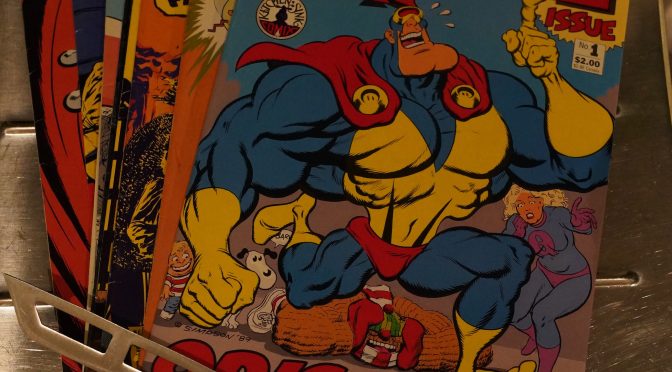
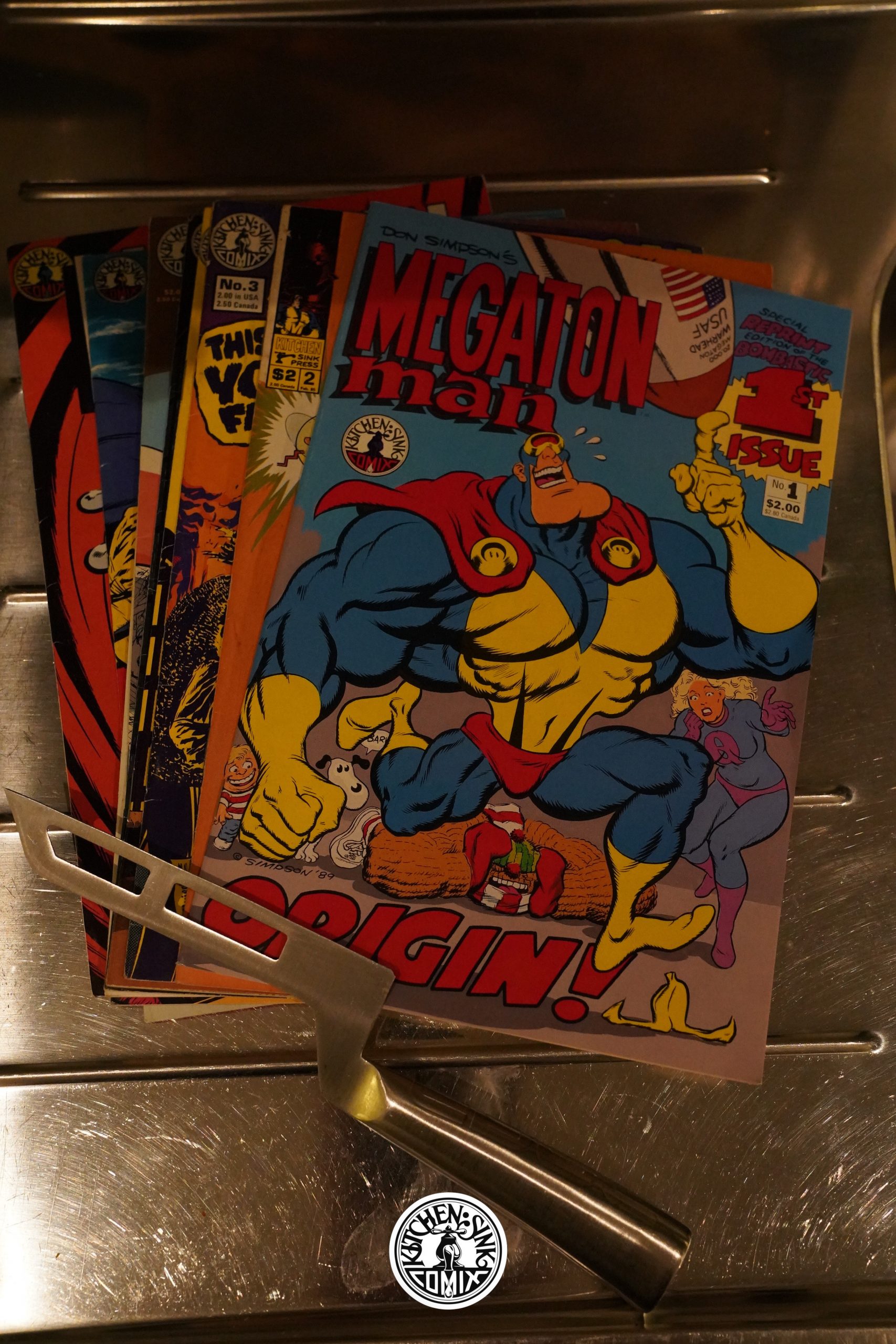
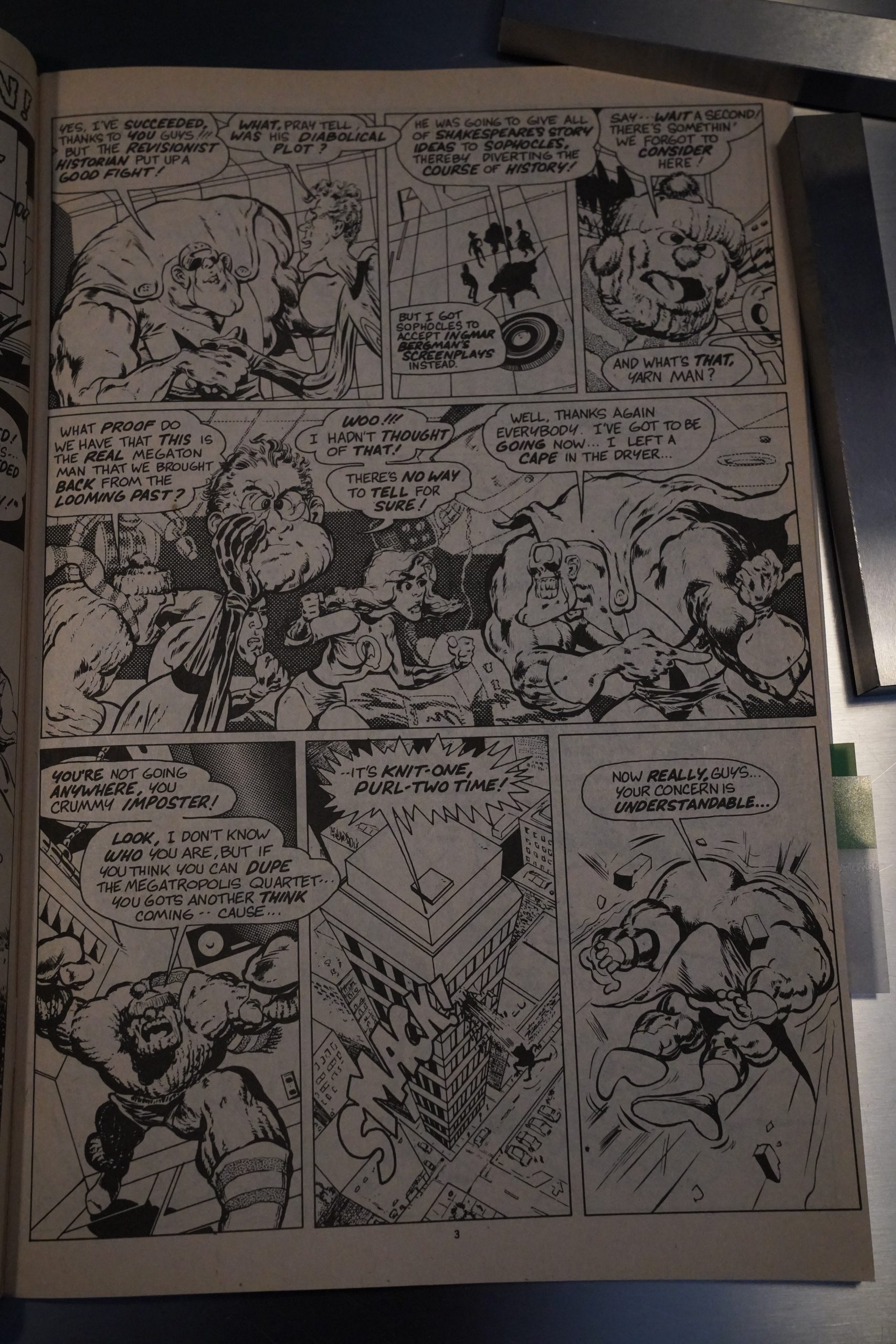
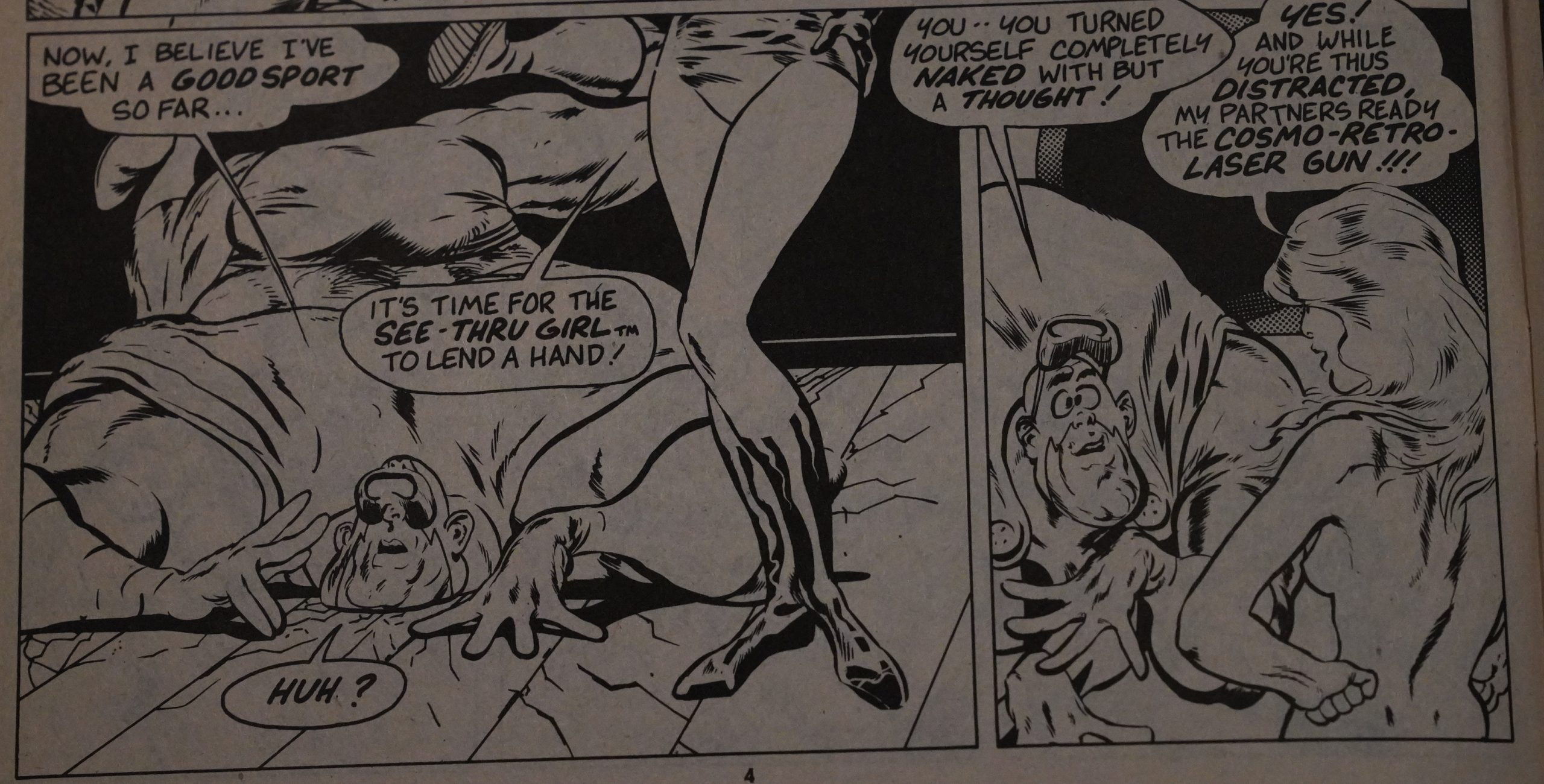
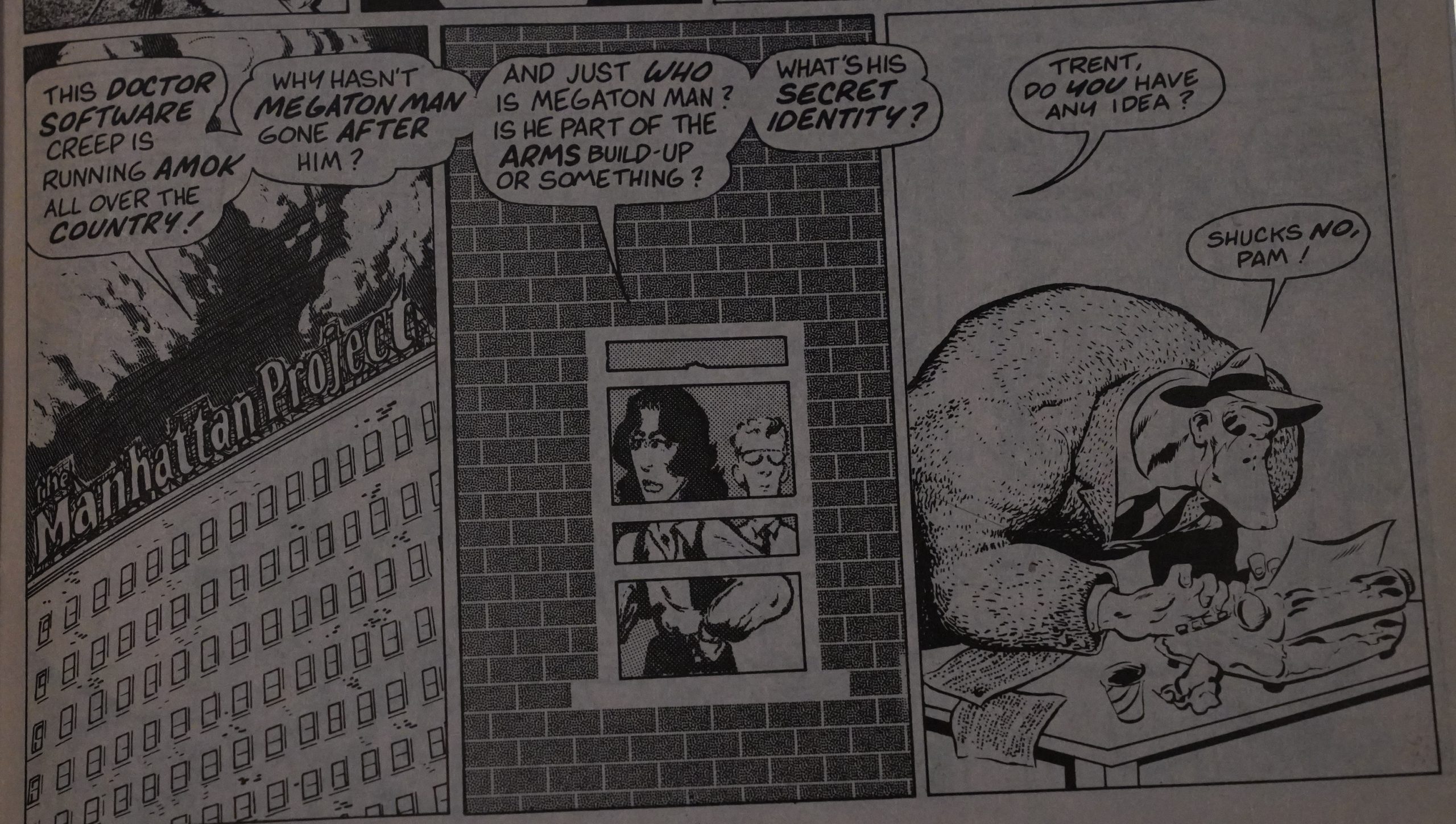
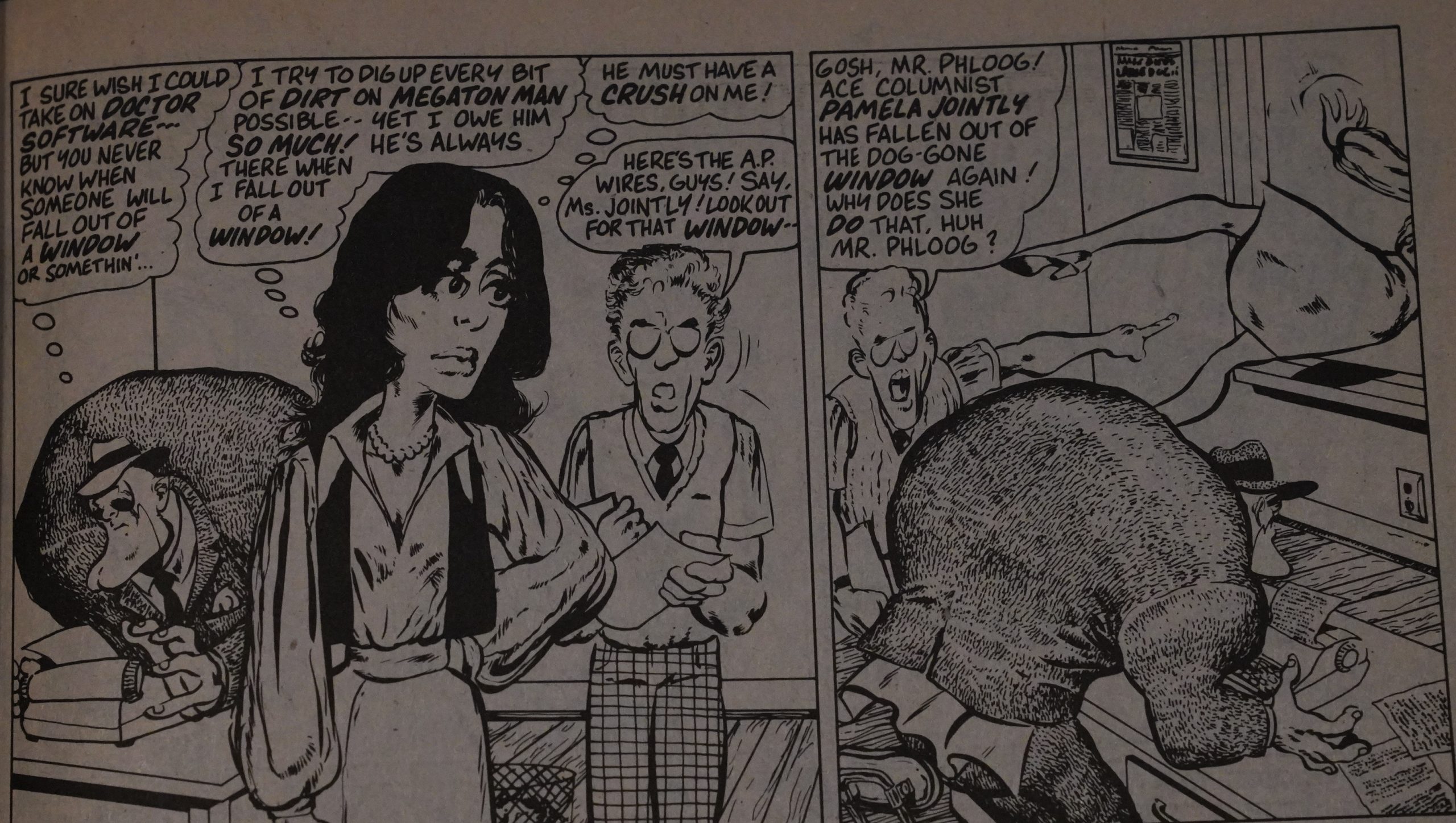
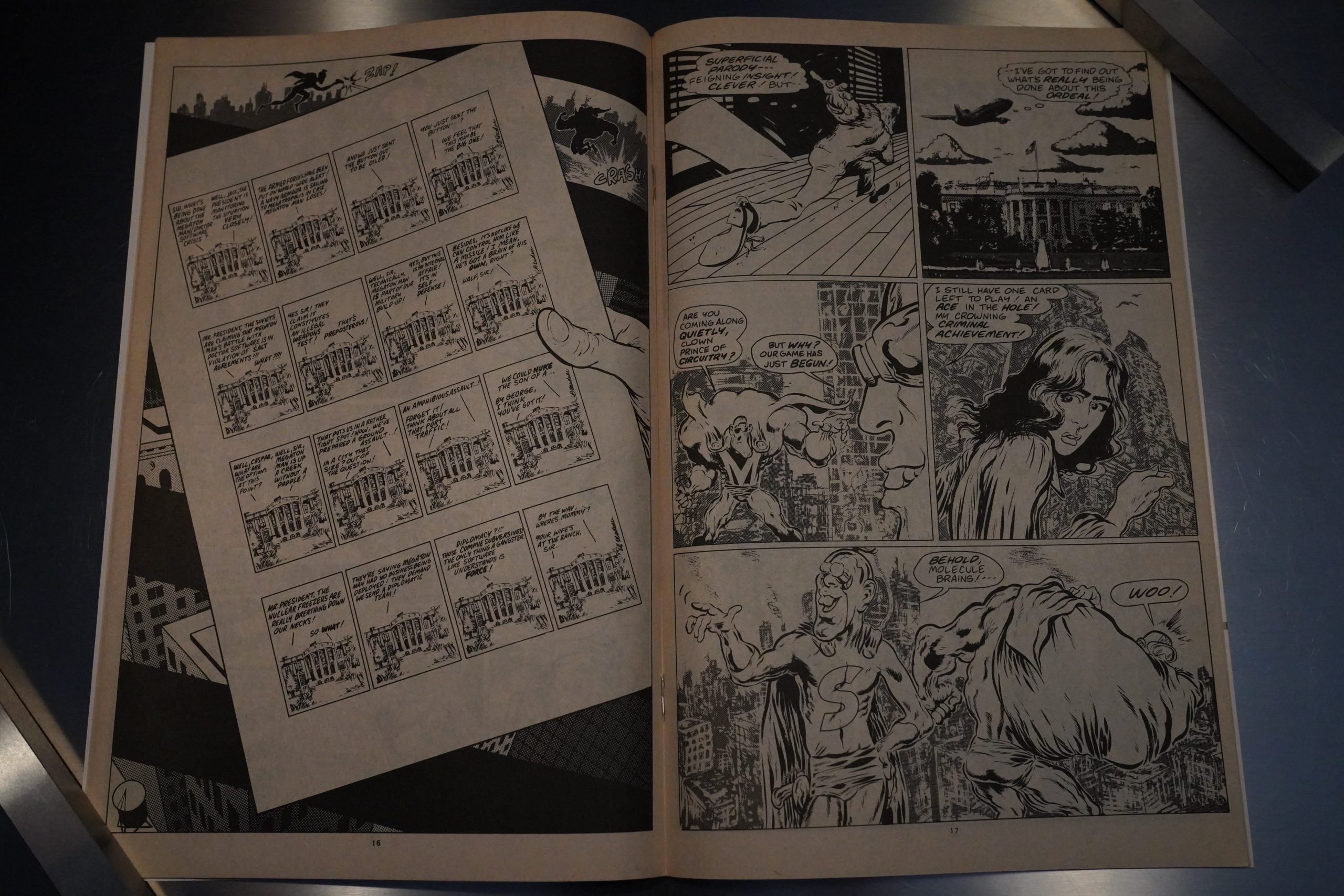
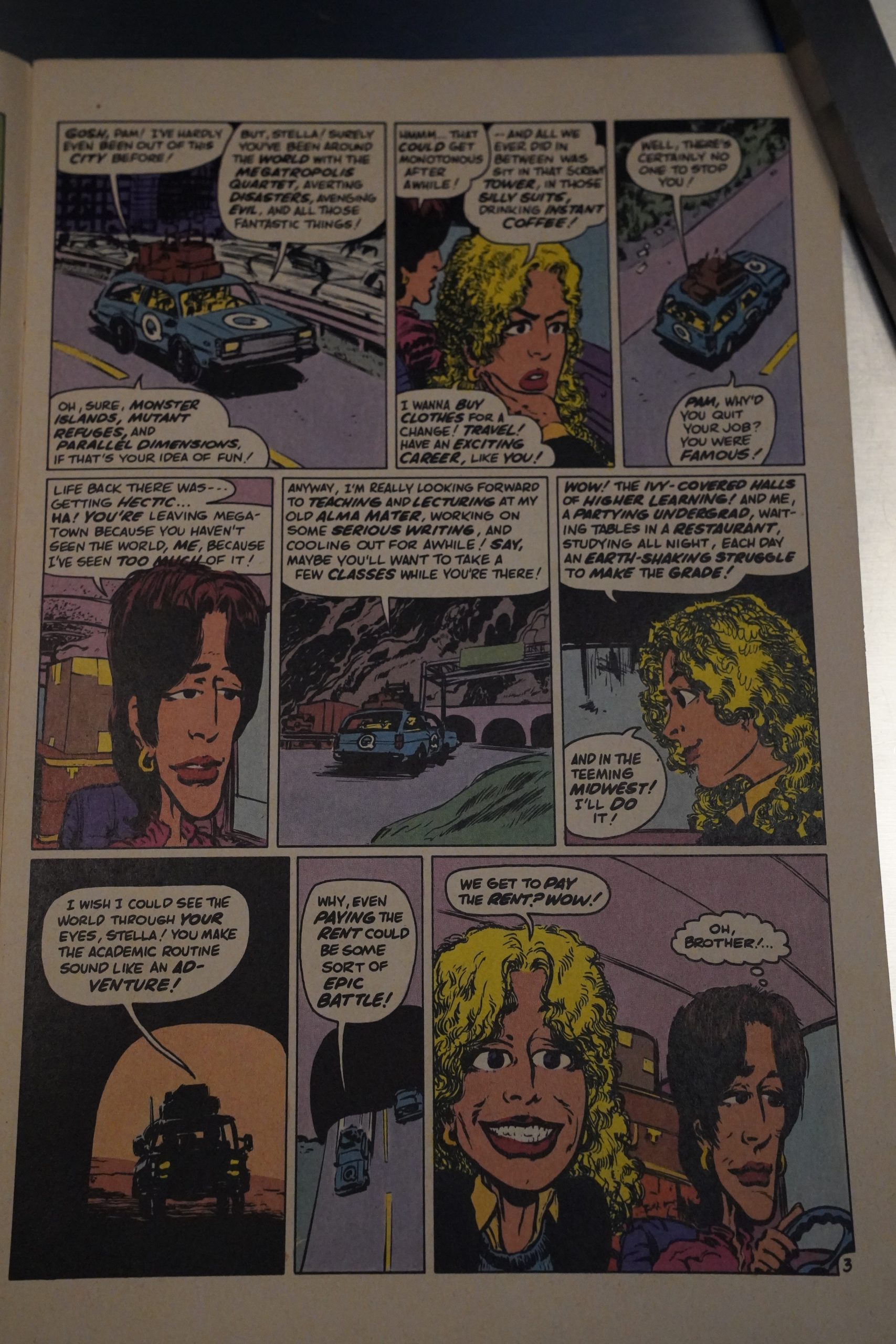

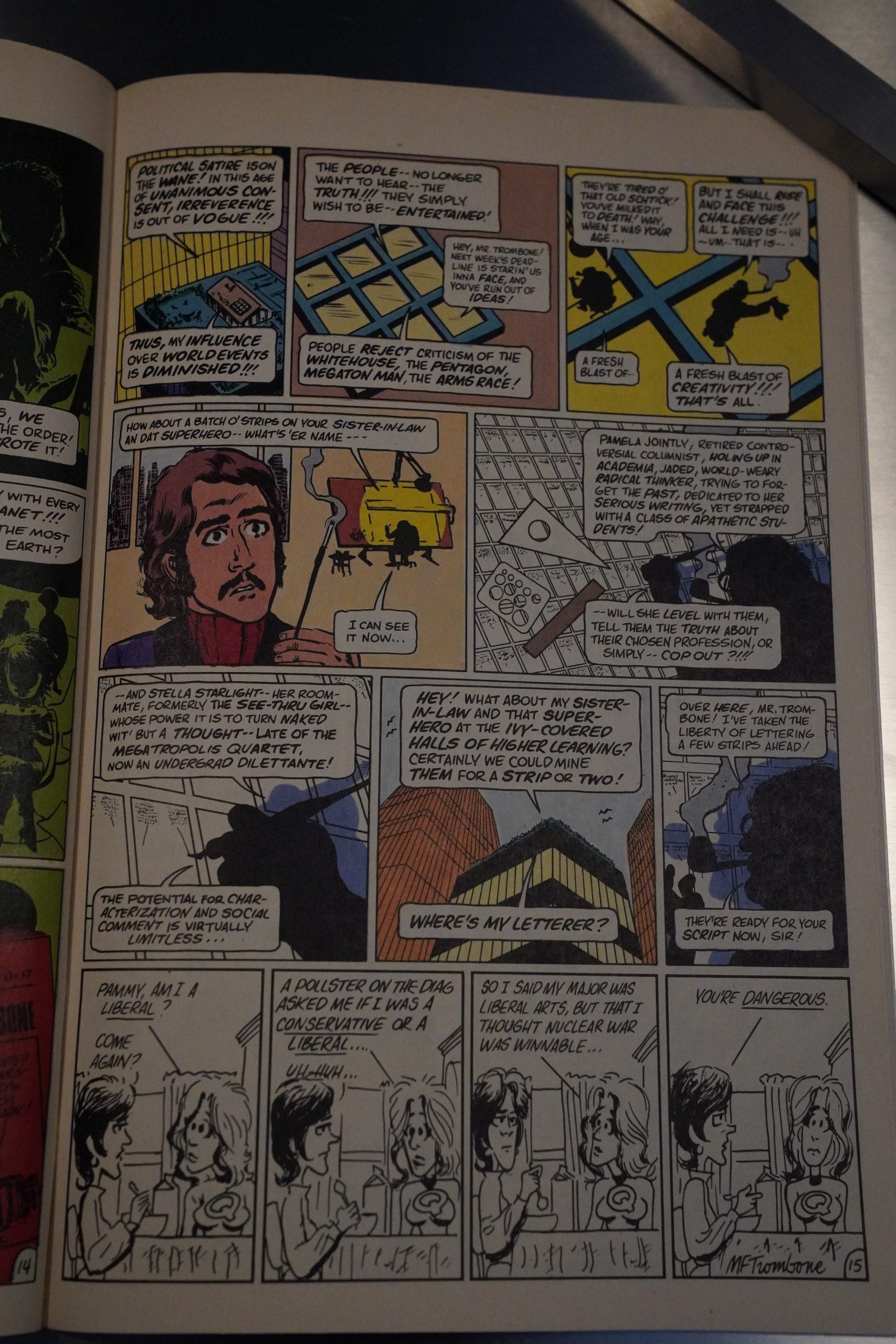
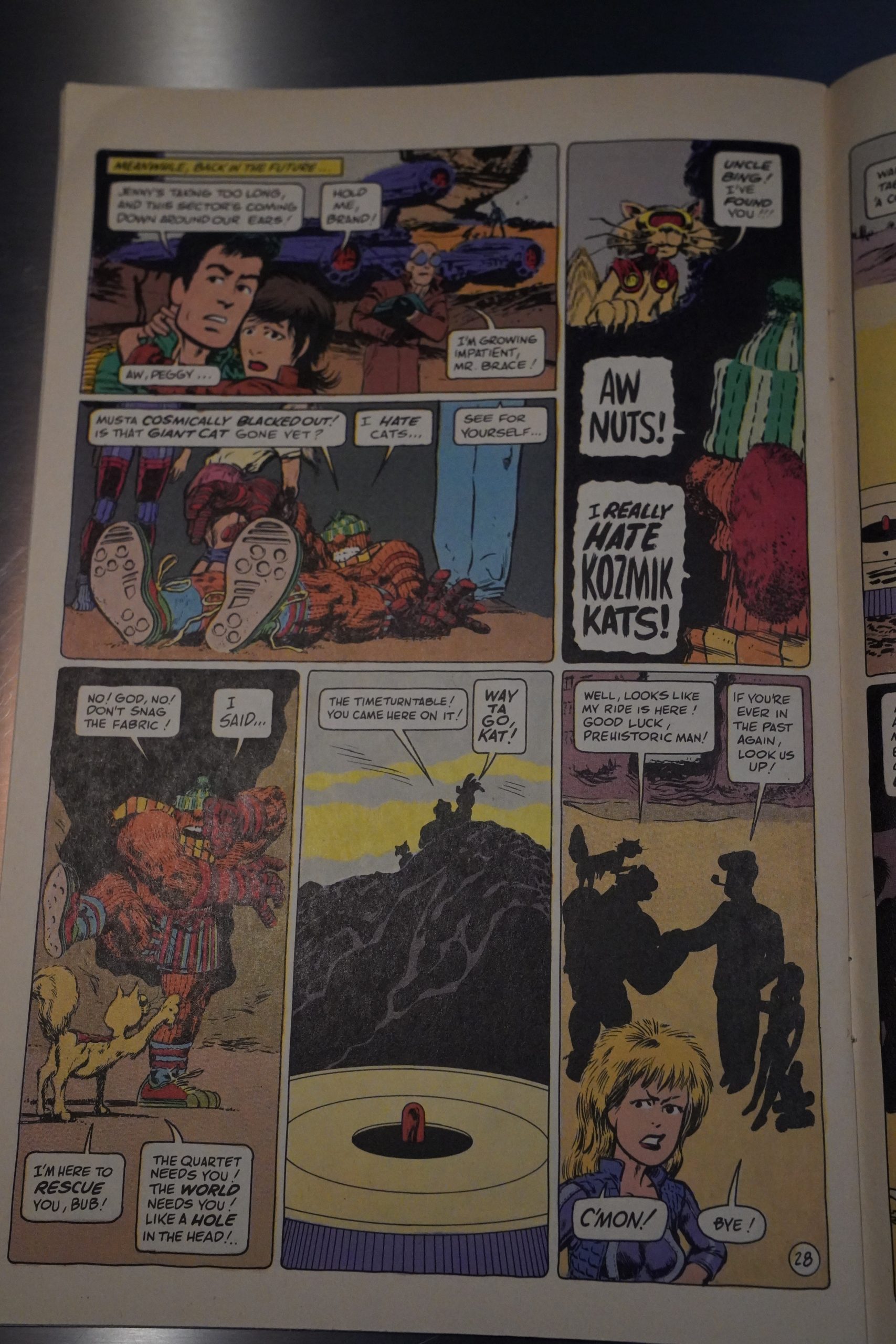
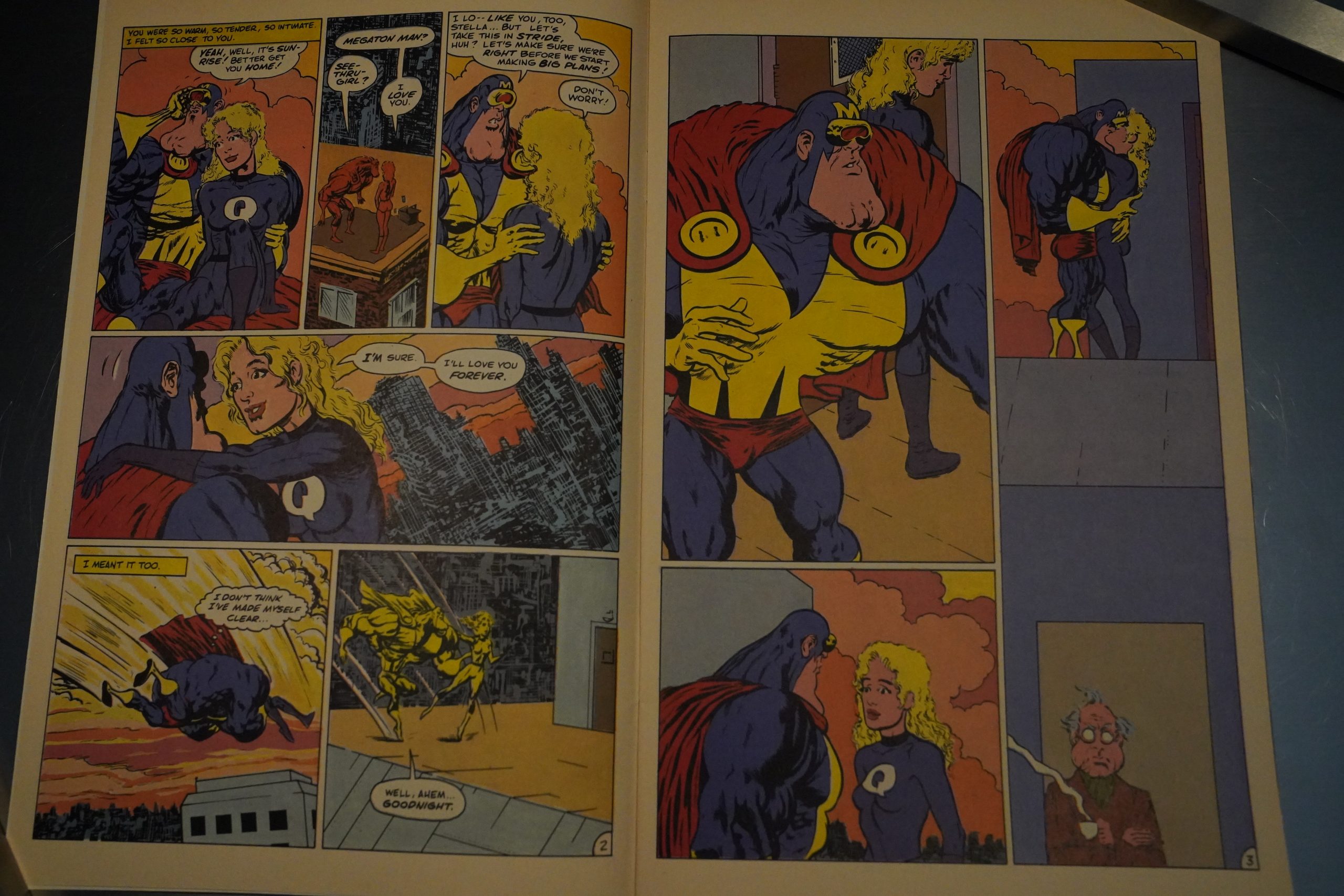
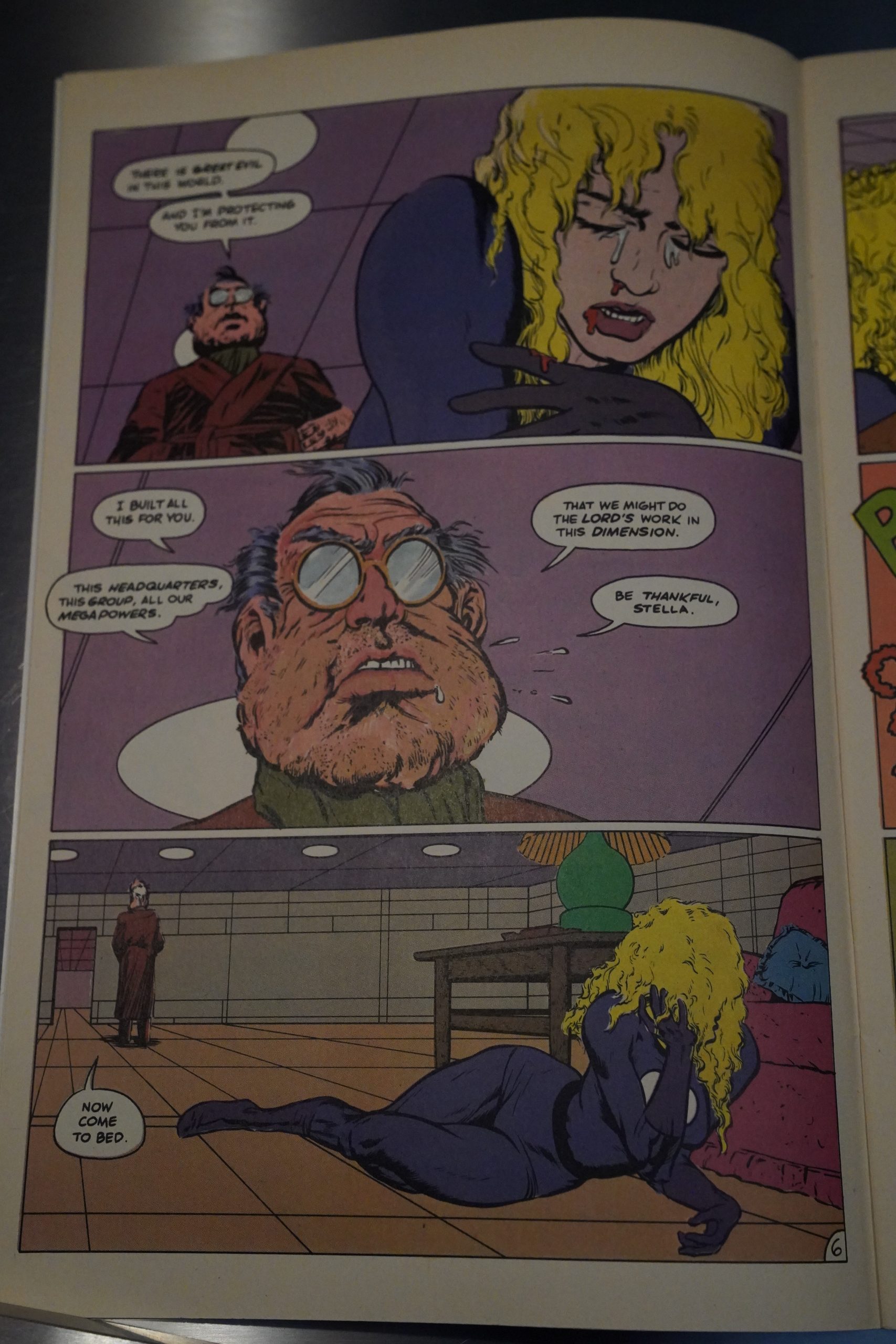
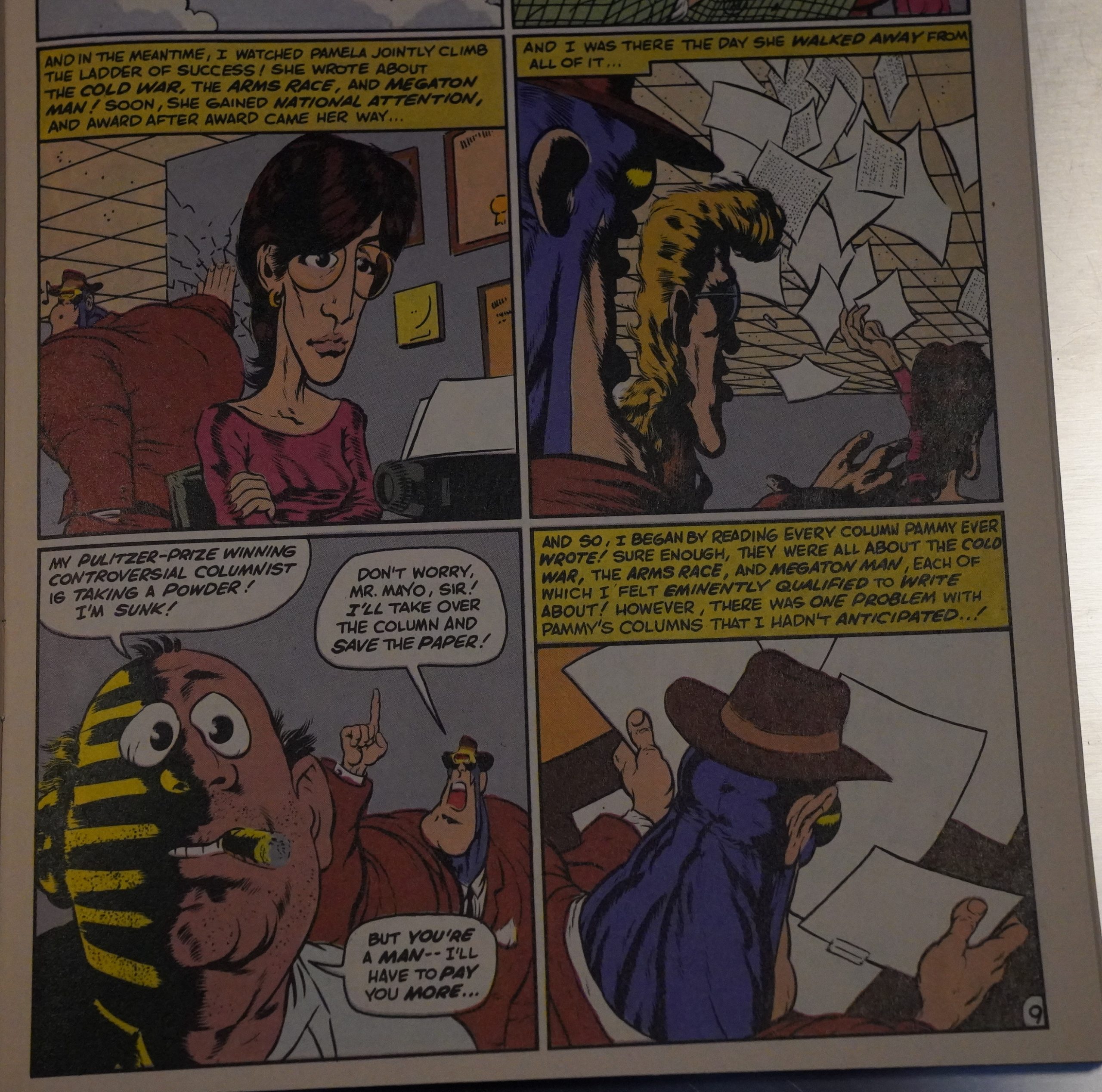
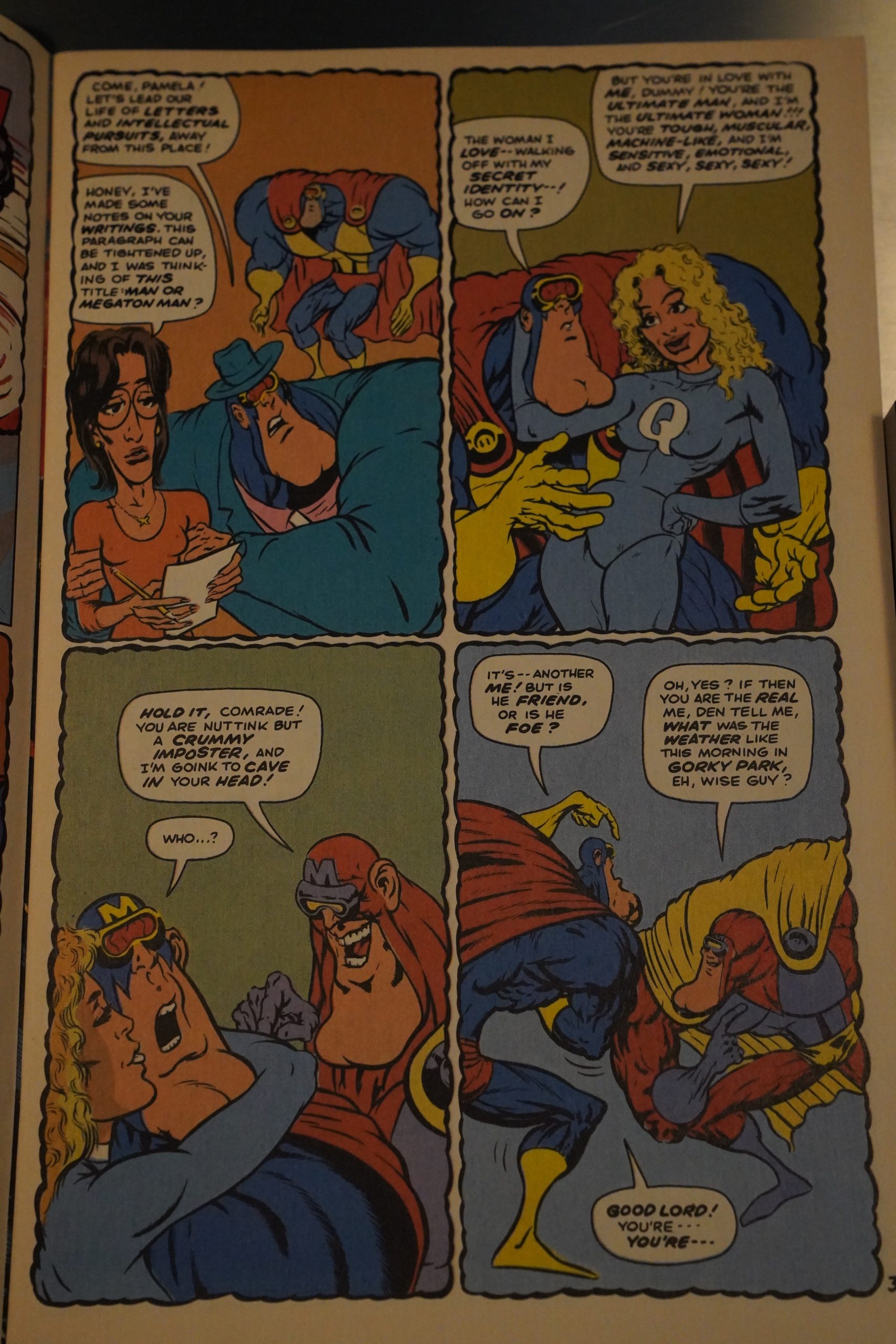
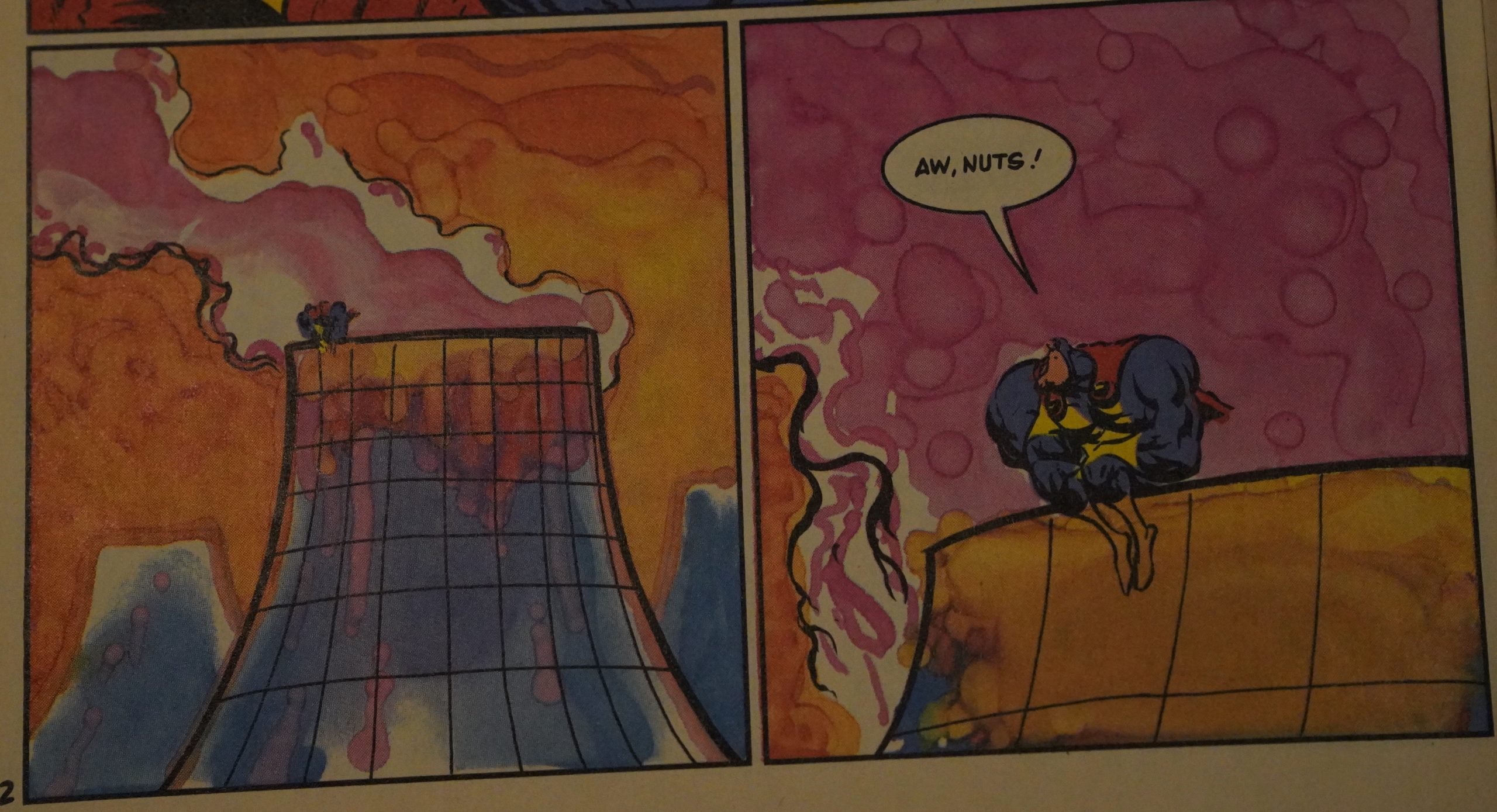
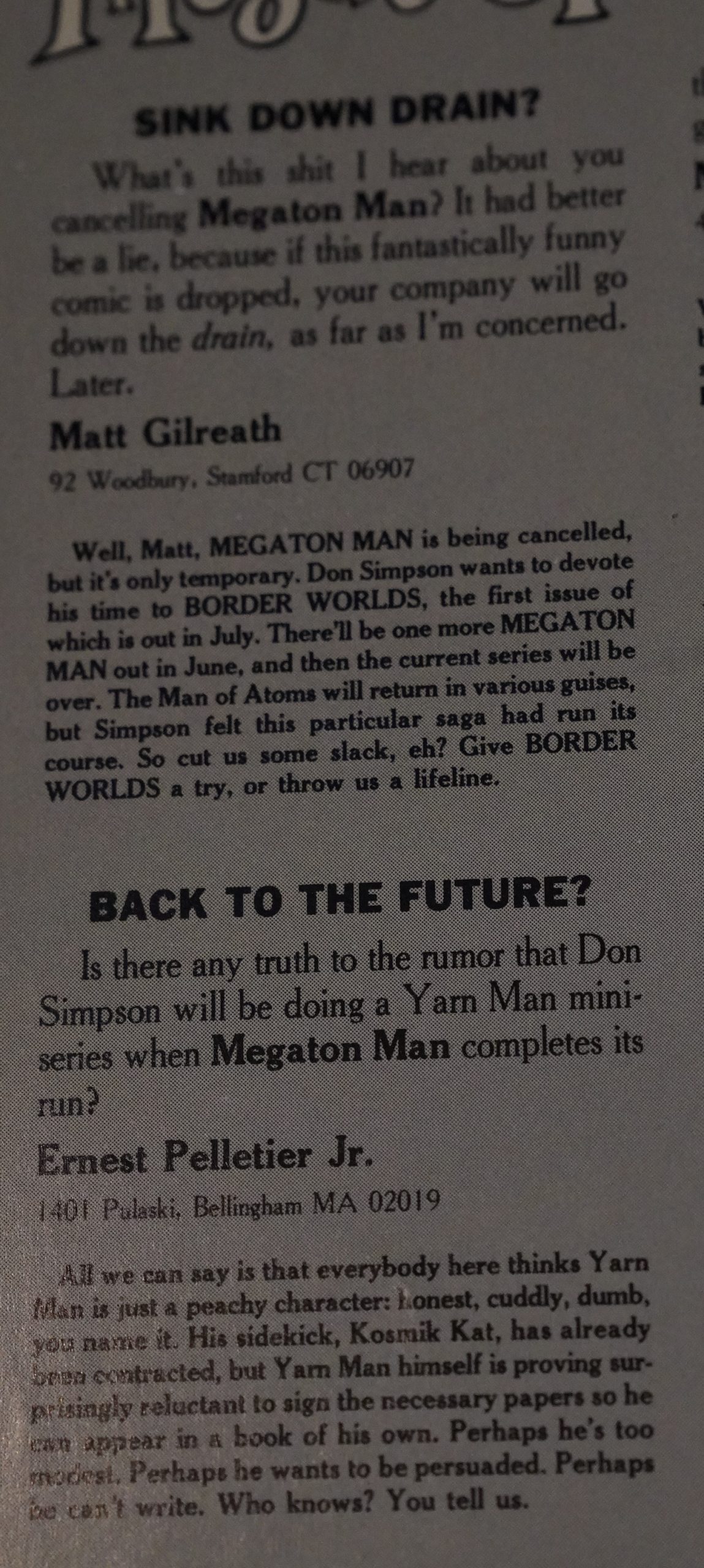
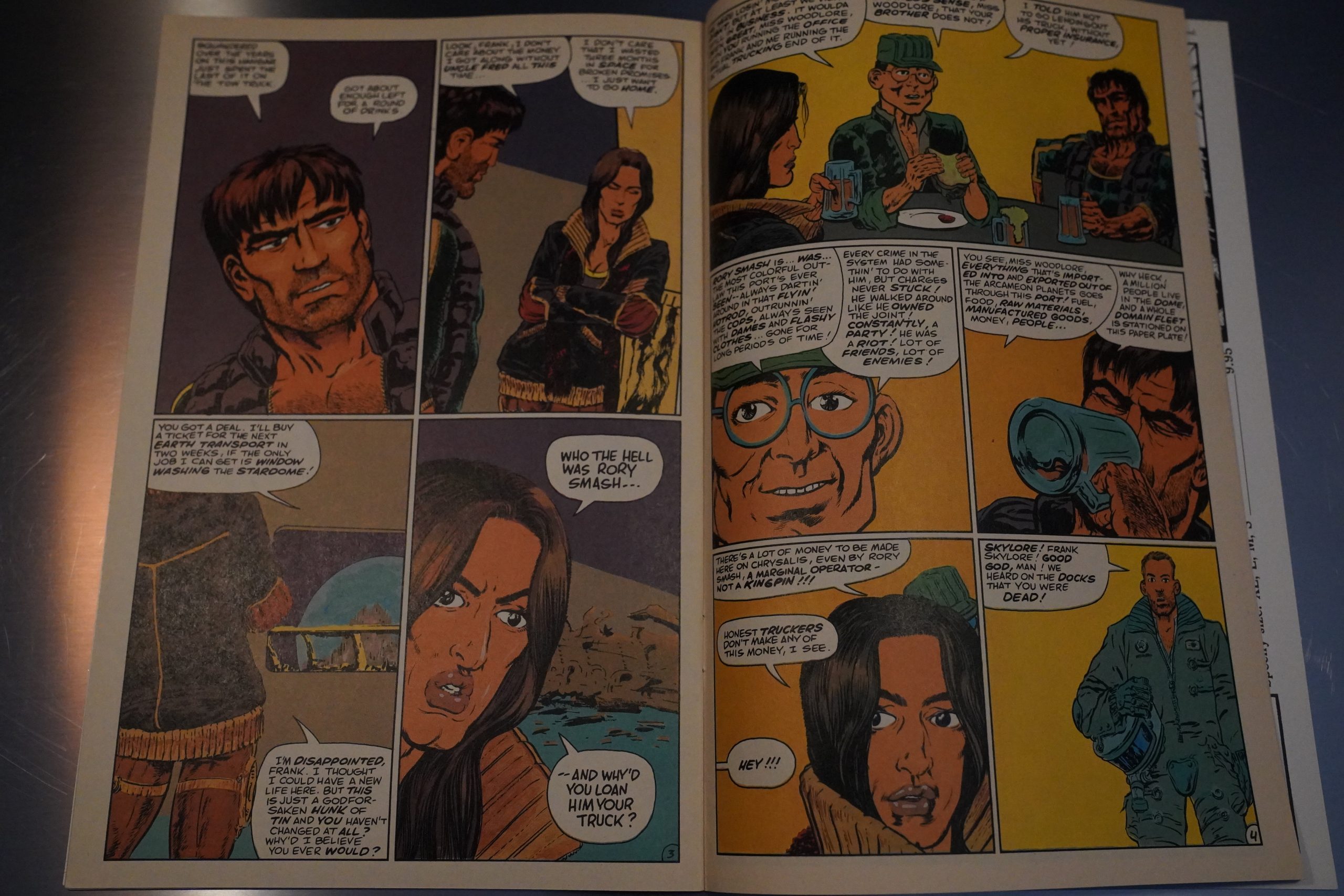

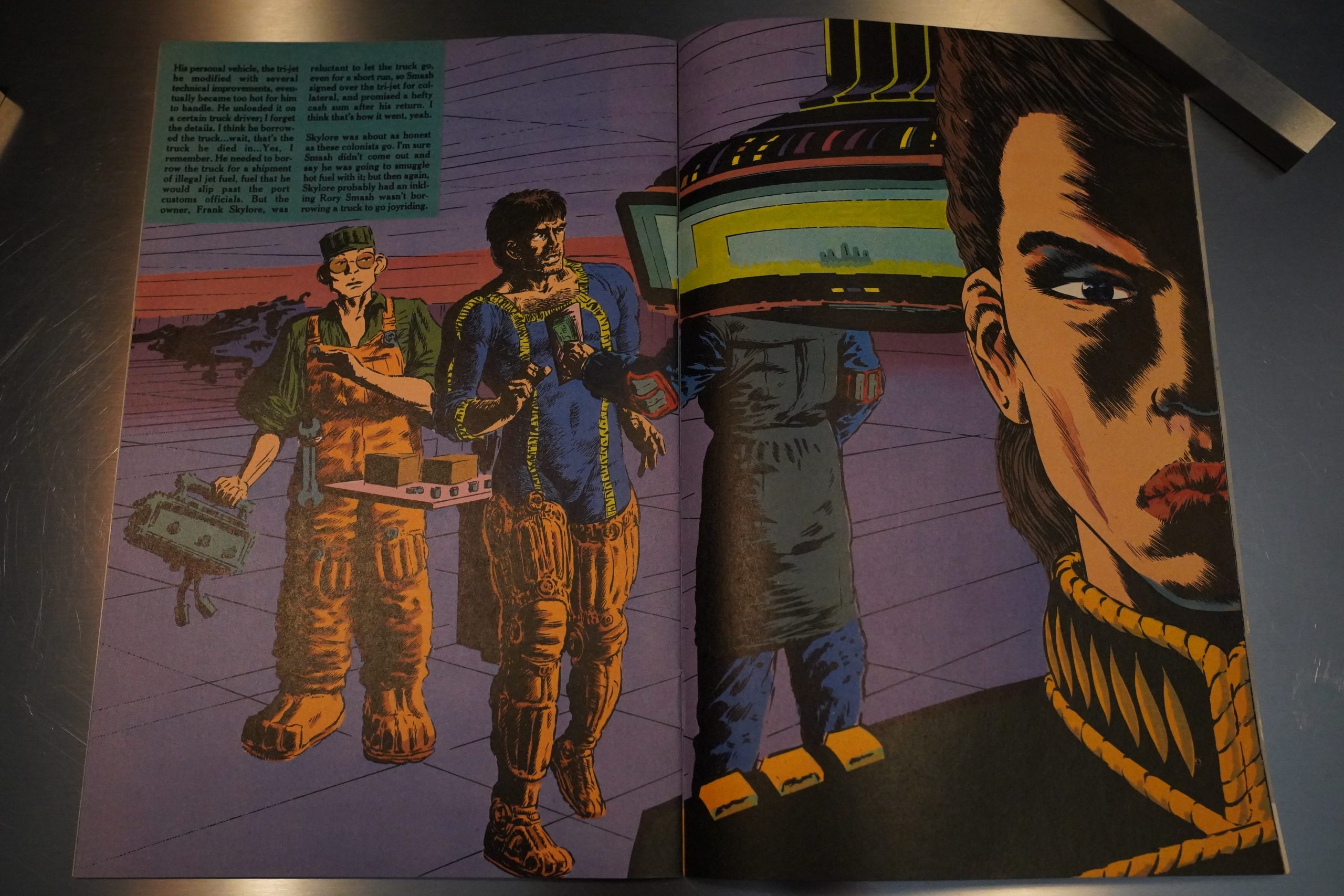

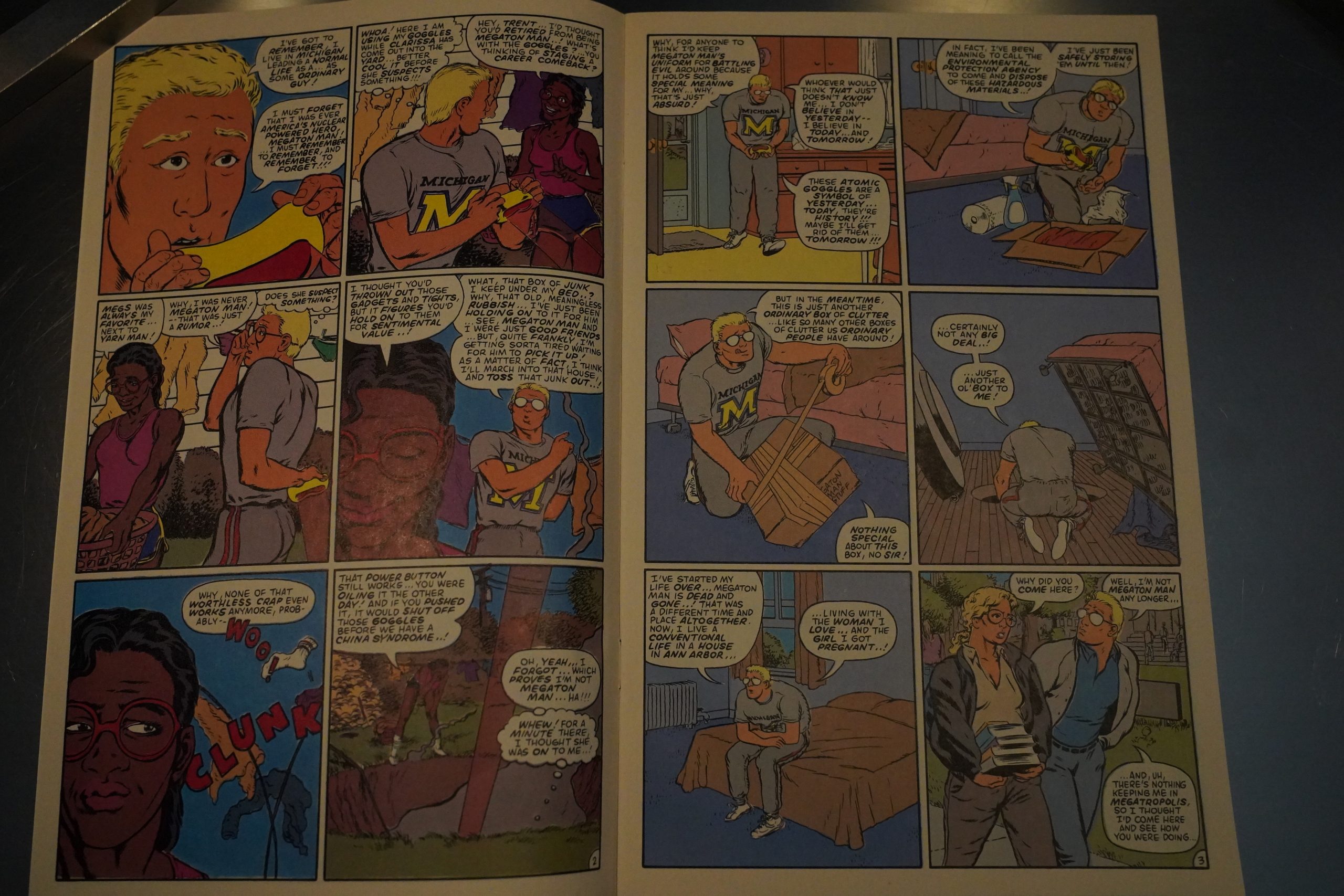
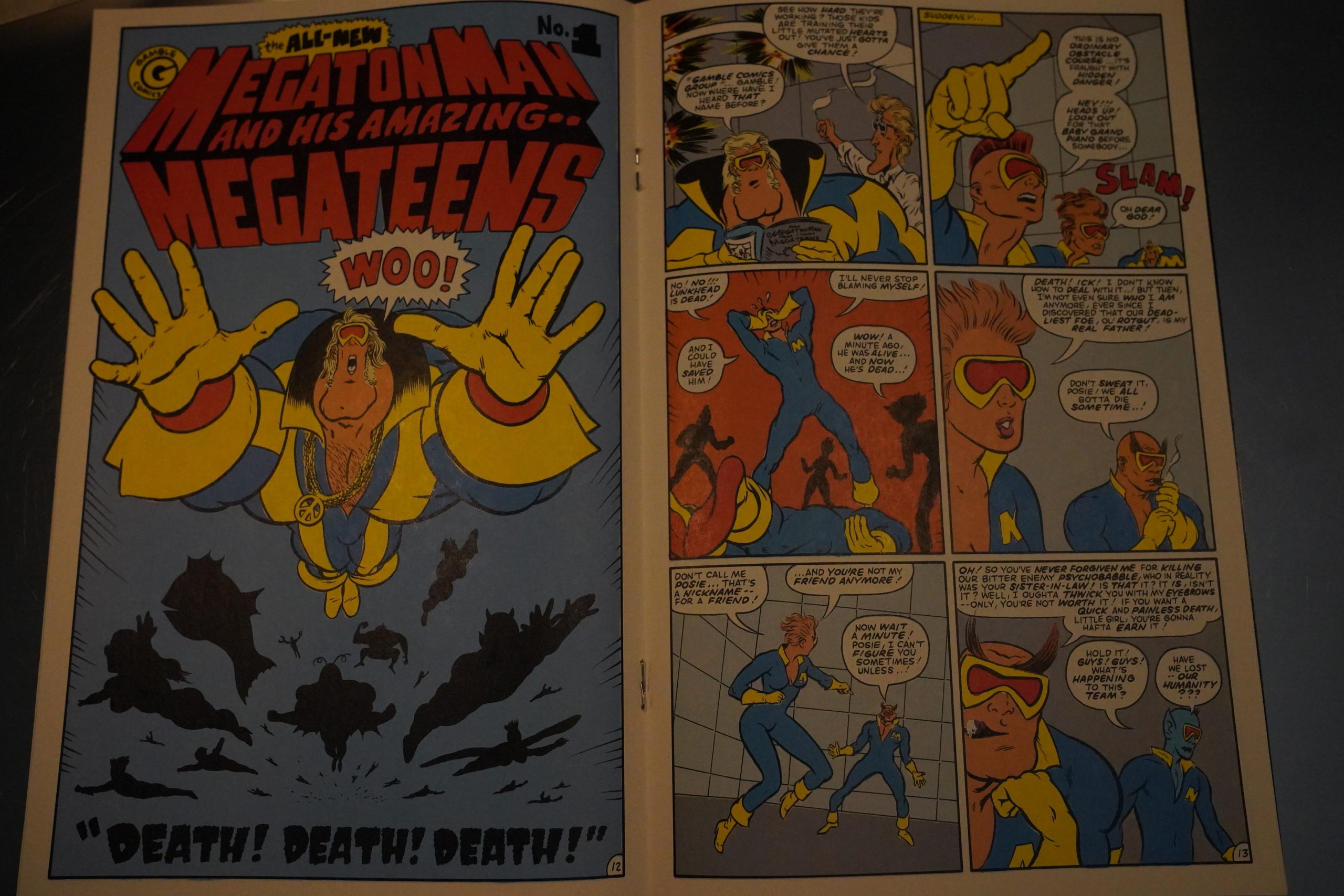

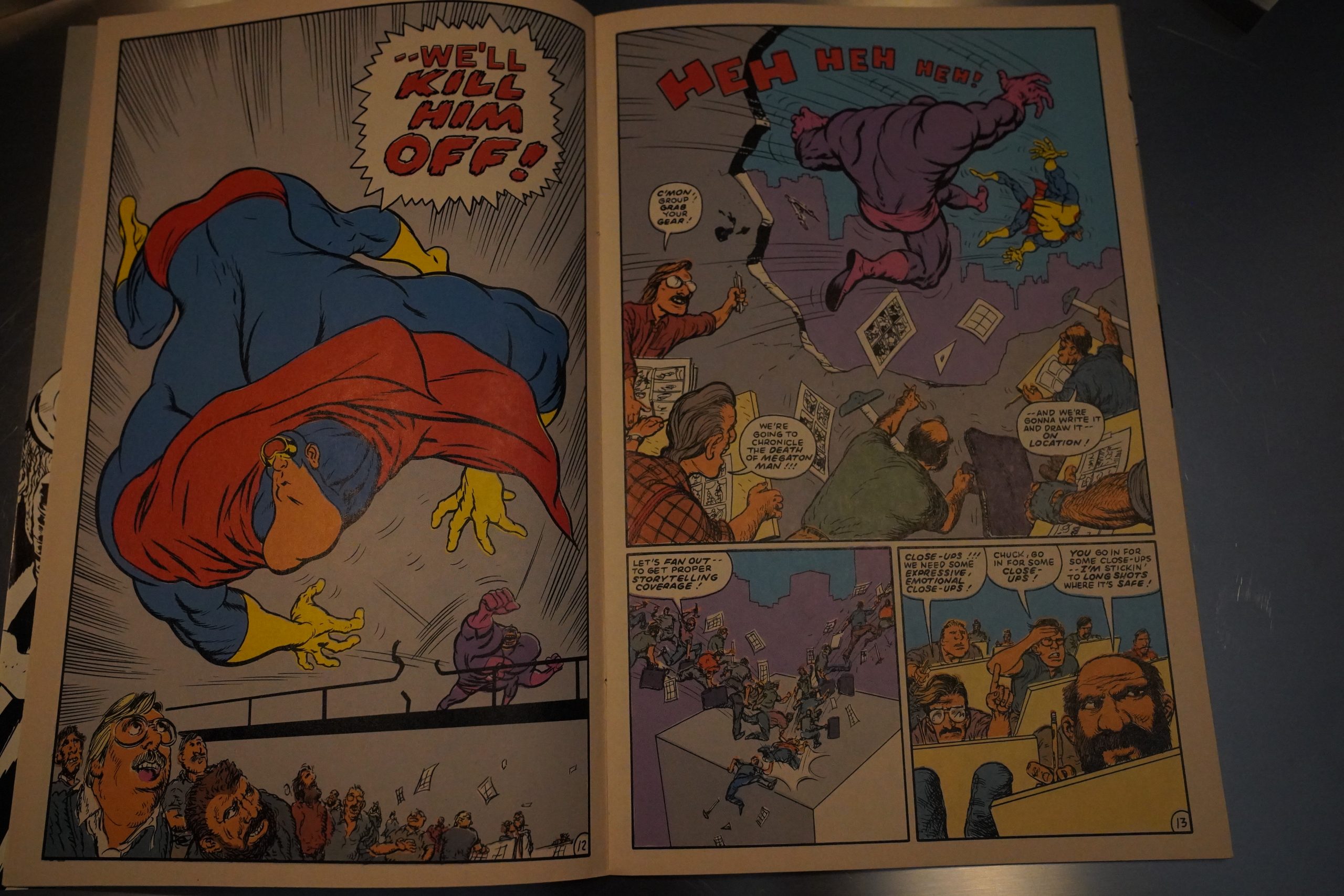


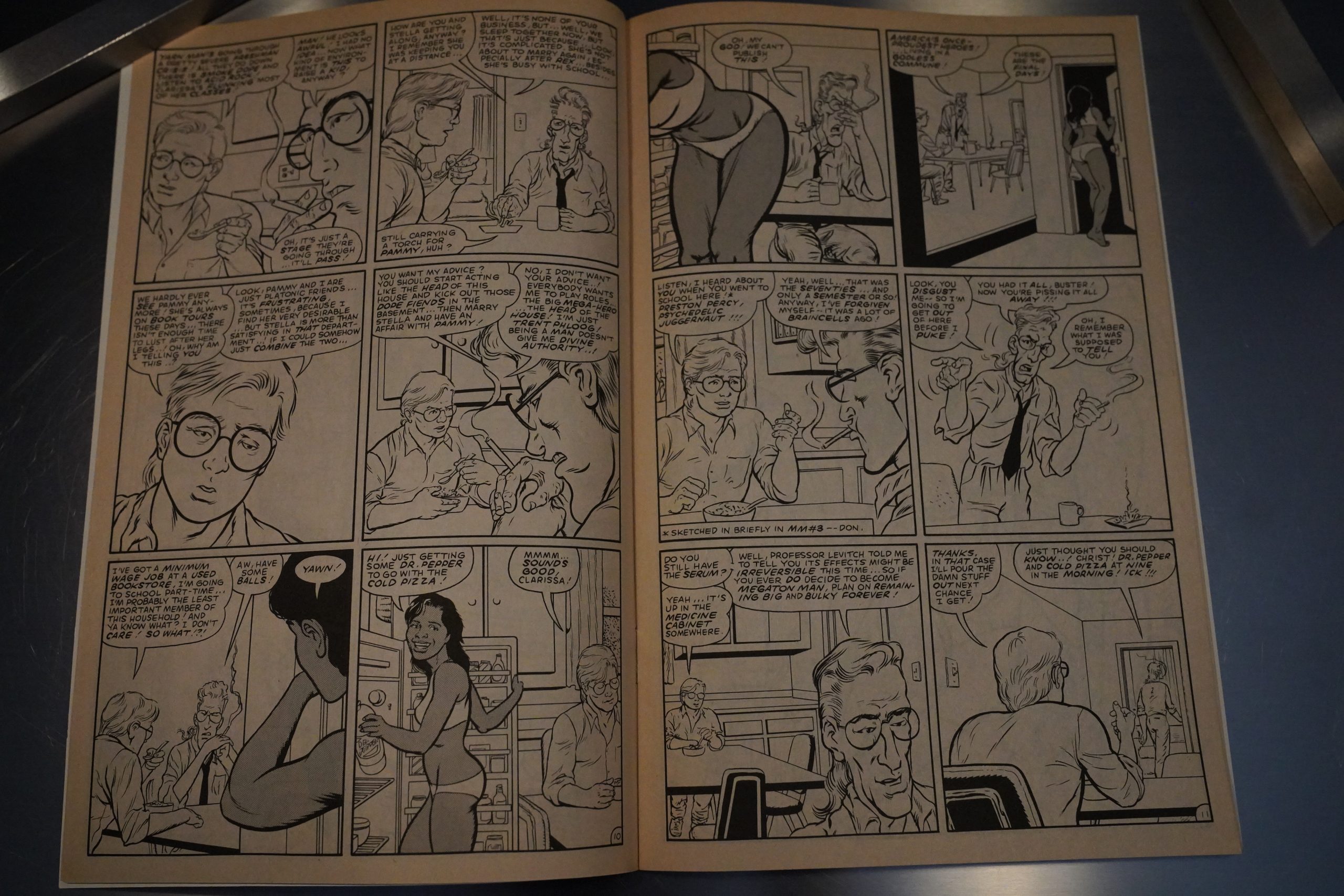

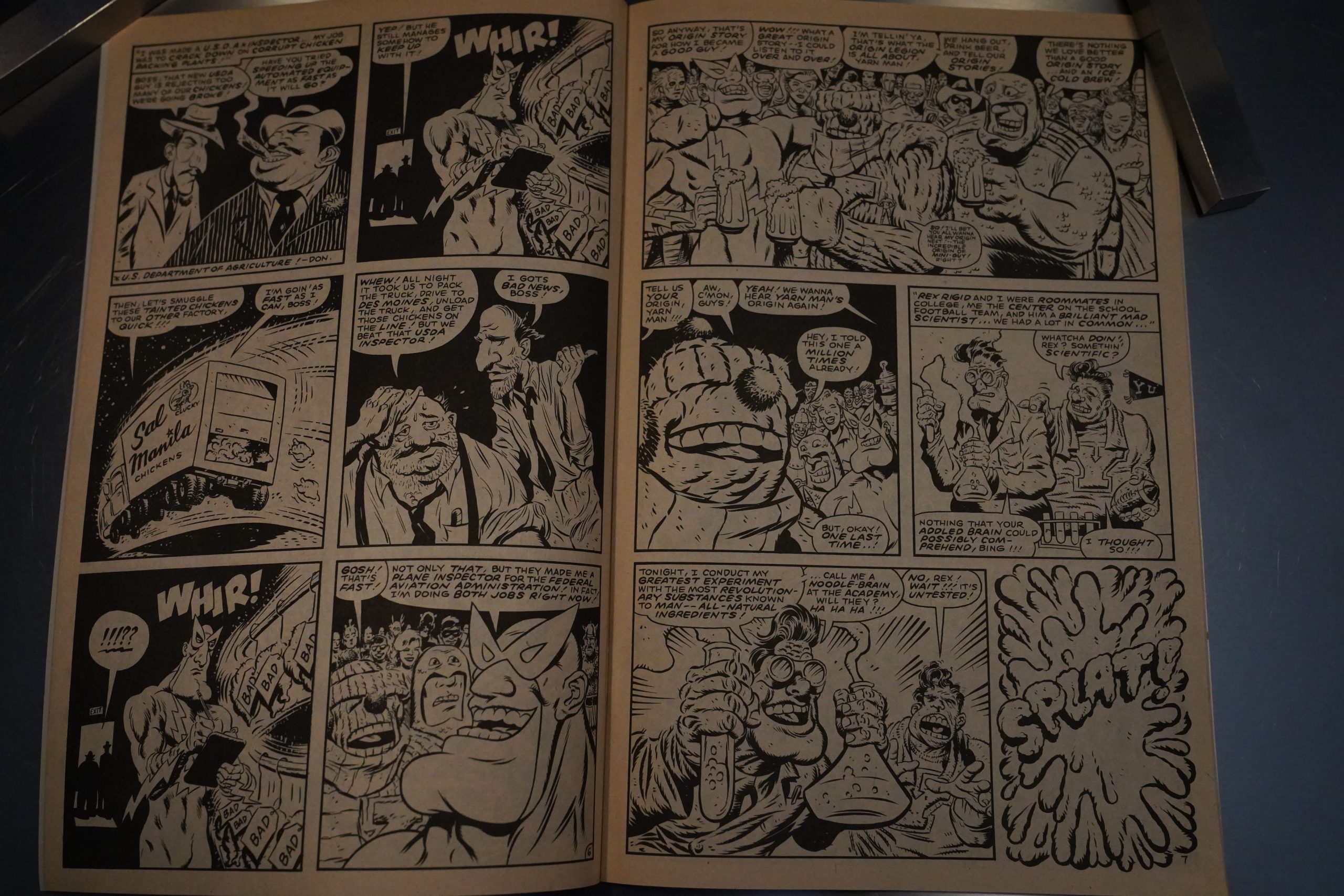
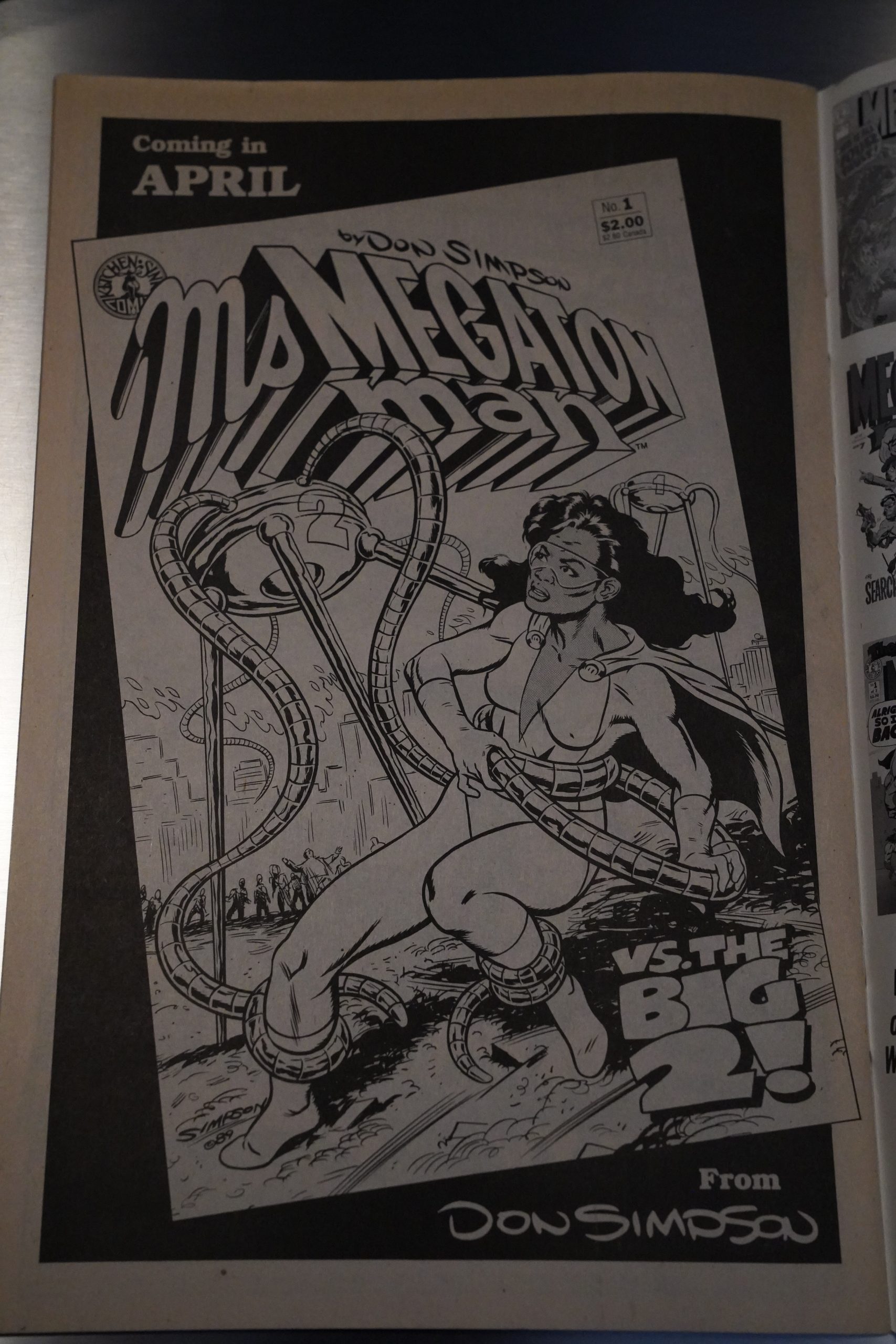
One thought on “1984: Megaton Man &c”